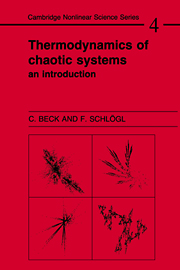Book contents
- Frontmatter
- Contents
- Preface
- Introduction
- PART I ESSENTIALS OF NONLINEAR DYNAMICS
- PART II ESSENTIALS OF INFORMATION THEORY AND THERMODYNAMICS
- PART III THERMOSTATISTICS OF MULTIFRACTALS
- 9 Escort distributions
- 10 Fractals
- 11 Multifractals
- 12 Bit-cumulants in multifractal statistics
- 13 Thermodynamics of finite volume
- PART IV DYNAMICAL ANALYSIS OF CHAOTIC SYSTEMS
- PART V ADVANCED THERMODYNAMICS
- References
- Index
9 - Escort distributions
Published online by Cambridge University Press: 14 September 2009
- Frontmatter
- Contents
- Preface
- Introduction
- PART I ESSENTIALS OF NONLINEAR DYNAMICS
- PART II ESSENTIALS OF INFORMATION THEORY AND THERMODYNAMICS
- PART III THERMOSTATISTICS OF MULTIFRACTALS
- 9 Escort distributions
- 10 Fractals
- 11 Multifractals
- 12 Bit-cumulants in multifractal statistics
- 13 Thermodynamics of finite volume
- PART IV DYNAMICAL ANALYSIS OF CHAOTIC SYSTEMS
- PART V ADVANCED THERMODYNAMICS
- References
- Index
Summary
Suppose we have an arbitrary, possibly fractal, probability distribution. For example, this might be the natural invariant density of a chaotic map. We wish to analyse the most important properties of this complicated distribution in a quantitative way. A fundamental idea, which has turned out to be very useful in nonlinear dynamics, is the following. To a given probability distribution a set of further probability distributions is attributed, which, in a way, have the ability to scan the structure of the original distribution. These distributions have the same form as thermodynamic equilibrium distributions and yield the key for various analogies between chaos theory and thermodynamics. We shall call them ‘escort distributions’. The considerations of this chapter are valid for arbitrary probability distributions, no matter how they are generated.
Temperature in chaos theory
Whereas in statistical thermodynamics probability distributions are sought on the basis of incomplete knowledge (usually only a few macroscopic variables are given, which are interpreted as statistical mean values), in chaos theory the central question can sometimes be reversed in a sense: here the distributions p may be given in the form of observed relative frequencies in a computer experiment. Then a characterization of the system is sought using relatively few global quantities that describe the relevant features. In thermodynamics we were led to the generalized canonical distribution by the unbiased guess.
- Type
- Chapter
- Information
- Thermodynamics of Chaotic SystemsAn Introduction, pp. 88 - 93Publisher: Cambridge University PressPrint publication year: 1993
- 1
- Cited by

